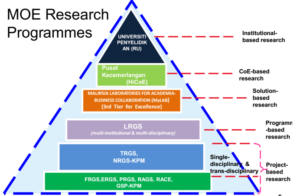GUP juga dikenali sebagai RUG (Research University Grant). The fund is actually from MOHE (under RU budget). RU – Only five RU eligible – they got special grant from MOHE (Thats why we are scared of MYRA – MYRA1 to get 100% instruments to be RU. Then, from RU fund – go to UTM as GUP (RU Grant) – Geran Universiti Penyelidik. For 2018, UTM open 5 types of GUP. The slide is here Taklimat Geran GUP:

GUP Tier 1 RM50K for S&T
- Project Leader Permanent sfaff – at least 2 members.
- Must related to people on the ground – berkonsep penyelesaian masalah industri/komuniti/agensi kerajaan.
- Proof of collaboration – e.g email: Contoh Surat Sokongan Jabatan Laut Letter of Support. Contoh: Permohonan Surat Sokongan Untuk Penyelidikan.
- 24 months
- collaborators recommend to collaborate as in kind or monetary.
- 20% travelling (v21) and 40% for buying equipment (v35)
- Penilaian: 1 cycle (2 evaluators)
- Output:
- 1 indexed journal for 20K,
- 100% geran luar (selain tajaan universiti dan networking grant iaitu geran sepadan daripada kerajaan, swasta, industri or antarabangsa)
- 1 student.
GUP Tier 2 (20K) 2018
- Project Leader Permanent sfaff – at least 2 members.
- NOT required but recommended: must related to people on the ground – berkonsep penyelesaian masalah industri/komuniti/agensi kerajaan.
- Thats why, this is for people that do not have any grant.
- 12-15 months
- 20% travelling (v21) and 40% for buying equipment (v35)
- Penilaian: 1 cycle (2 evaluators)
- Output:
- 1 indexed journal for 20K,
- 100% geran luar (selain tajaan universiti dan networking grant iaitu geran sepadan daripada kerajaan, swasta, industri or antarabangsa)
- NO NEED to produce 1 student.
For 2019, There are amendment for GUP Tier 2 (30K for S&T). Please refer here for the latest info. GARIS PANDUAN GUP TIER 2 2019 -revised Dekan RA.
Basically, the Tier 2 is for new researcher to learn how to manage grants. There must be 1 Prof Madya as a mentor and 2 members to guide the process. The output is – 2 Indexed Scopus Papers or 1 Q1/Q2.
GUP CRG (RM100K)
- Project Leader Permanent sfaff – at least 2 members.
- Must work with other university (40k for UTM, 60 for 3 collaborators)

